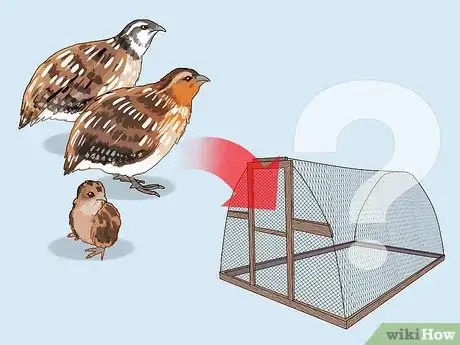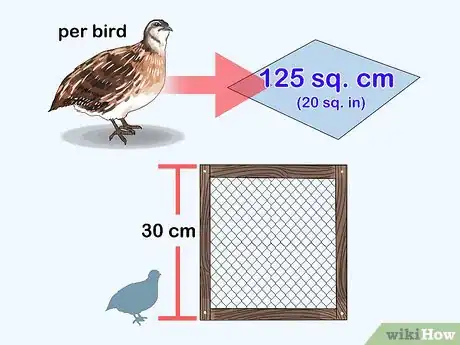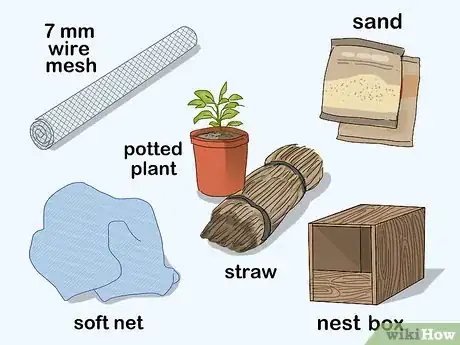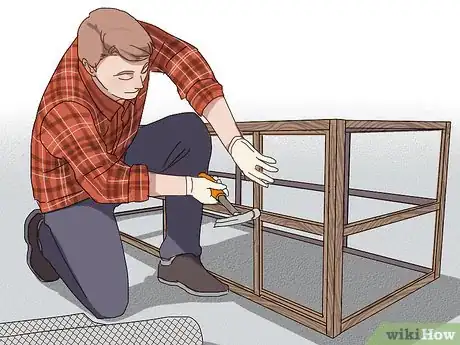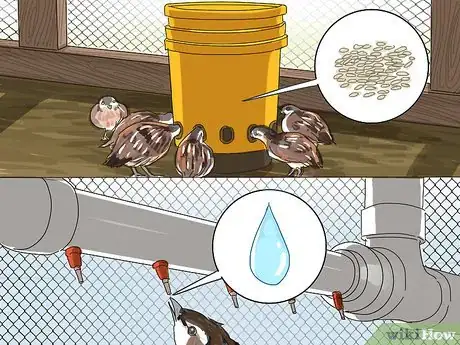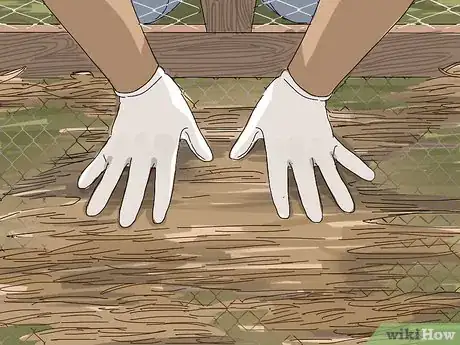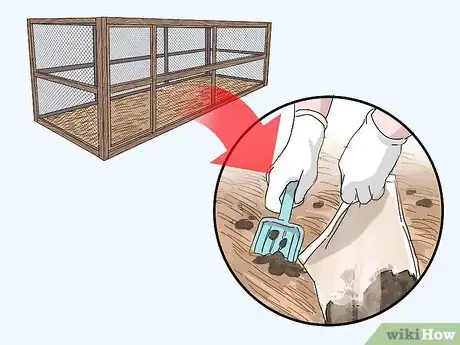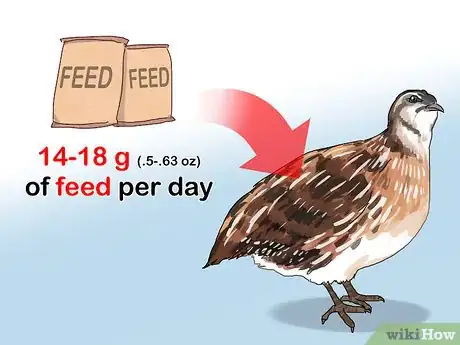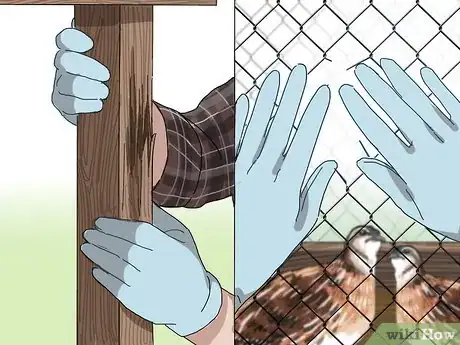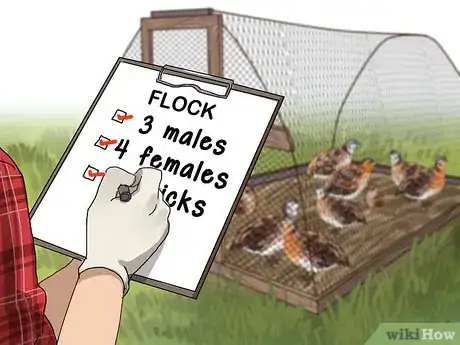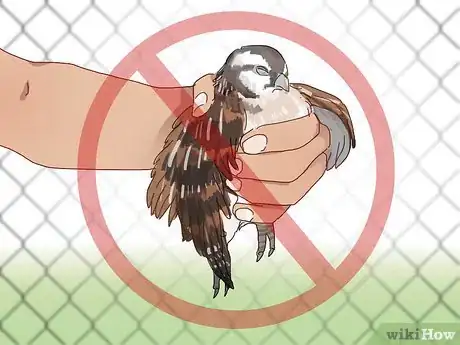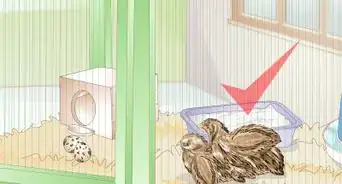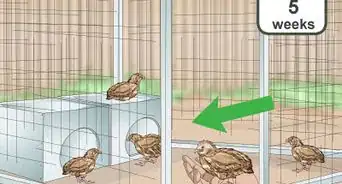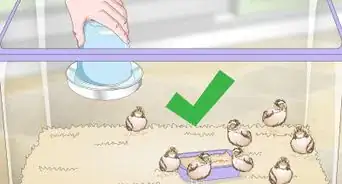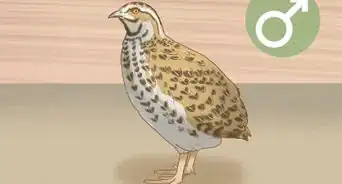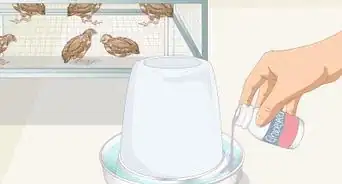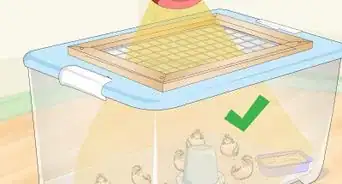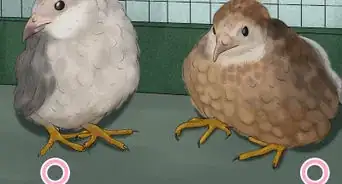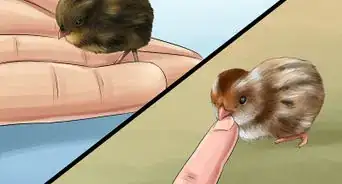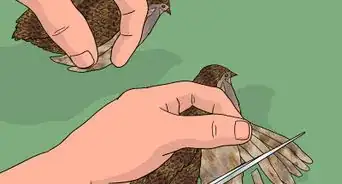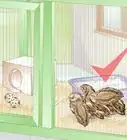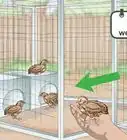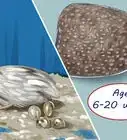This article was co-authored by Ryan Corrigan, LVT, VTS-EVN and by wikiHow staff writer, Megaera Lorenz, PhD. Ryan Corrigan is a Licensed Veterinary Technician in California. She received her Bachelor of Science in Veterinary Technology from Purdue University in 2010. She is also a Member of the Academy of Equine Veterinary Nursing Technicians since 2011.
There are 7 references cited in this article, which can be found at the bottom of the page.
wikiHow marks an article as reader-approved once it receives enough positive feedback. In this case, 94% of readers who voted found the article helpful, earning it our reader-approved status.
This article has been viewed 173,543 times.
If you are interested in keeping quail, you will need to provide a good environment for your birds. Quail will thrive better and be healthier in a habitat in which they feel safe, secure, and at home. Since quail are social birds, they will need a habitat that is big enough to house multiple quail and offers not only shelter, but also space to forage and cover for hiding and nesting. Plan an appropriate type of enclosure and run for your flock, gather the materials you will need, and keep your quail healthy and happy by properly maintaining their habitat.
Steps
Planning Your Habitat
-
1Determine the size of the flock you want to keep. The type of habitat you build will depend on how many quail you plan to keep, what sex they are, and the reasons you are keeping them. You will need to factor these things in when planning the size of your habitat, how much feeding space to provide, and so on.[1]
- Quail are social birds, so your quail will be happiest and most comfortable if you keep them in groups.
- To minimize fighting and aggression, plan on keeping no more than 1 male for every 4 females in the group. If you plan to keep only males, they should be housed in pairs.
- If you are planning to keep quail for breeding, you may wish to keep them in relatively small groups, e.g., one male and two or three females. [2]
- Females can be kept in large groups, as long as there is sufficient space for all the birds (125 sq. cm, or about 20 sq. in, per bird).
- However, even a group of females will quickly establish a hierarchy or pecking order, so you will need to use caution when introducing new birds to the group once your flock is established.
-
2Provide adequate space. Quail need plenty of space to exercise, hide, and eat. Since they can fly, your habitat will also need enough vertical space to accommodate the birds’ vertical flight instinct that can kick in if they are scared or startled.[3]
- As a general rule of thumb, your enclosure should offer 125 sq. cm (about 20 sq. in) per bird.
- Your quail habitat needs to be at least 30 cm (about 1 foot) high in order to accommodate vertical flight without causing injury to the quail.
- If you are keeping quail in order to produce eggs, you may need to keep your birds in a relatively small habitat (like a hutch or pen, rather than a shed or aviary).[4]
- Quail may hide their eggs in the litter on the bottoms of their habitats, so eggs can be difficult to find in a larger enclosure or pen. However, you should still provide at least 125 sq. cm (about 20 sq. in) per bird.[5]
Advertisement -
3Provide sufficient light. Quail need plenty of light in order to produce eggs and to reach sexual maturity. Plenty of sunlight can also promote the growth of any plants you wish to add to your quail habitat. During the fall and winter months, you may need to introduce supplemental lighting in order to maintain egg production and fertility.[6]
- Japanese quail, one of the most popular types of domestic quail, must have 14-18 hours of light per day to maintain optimum fertility and egg production.
- If you are keeping your quail for meat production only, less light (e.g., about 8 hours per day) is needed.
-
4Gather the supplies you will need. The necessary supplies for building a quail habitat will vary depending on the type of enclosure you plan to build, but at minimum you will need:[7]
- 7 mm (approximately .25 in) wire mesh to secure the sides of your habitat.
- Appropriate floor cover. Quails do best in enclosures with solid floors covered in litter made of sand, soft wood shavings, or straw.
- Potted plants, artificial plants, shrubs, cut conifer branches, or small hay bales to provide cover and hiding places.
- Simple nest boxes.
- Sand for dustbathing.
- Flexible roof material to prevent head injuries during vertical flight. A soft net can be stretched just below the roof of the quail hutch or run in order to minimize the risk of injury.[8]
Constructing Your Habitat
-
1Construct a pen or shelter. This can be as simple as converting a rabbit hutch, which should be well ventilated and big enough to house about 6 quail (750 sq. cm, or about 300 sq. in). If you are planning to keep a larger number of quail, you will need a bigger pen or aviary.[9]
- Do not use a chicken coop for housing quail as they do not perch like chickens.
- The housing area for the quail should be on or near the ground. Quail like to nest and forage or sleep on the ground.
- Unless you are able to install wire mesh under the house or provide a solid floor under the house (like concrete), you may need to raise the house off the ground slightly in order to keep rats and other pests from burrowing in.
- If you must raise the house off the ground, try to raise it no more than 10 cm (about 4 inches), and provide a shallow ramp that the quail can use to enter and exit.
- Make sure the shelter is roofed so that the quail will have shelter from the sun and the elements.
-
2Construct a run or flight pen. Your quail will be happiest if they are able to spend time roaming and foraging. If you house your quail in cages or a small hutch, consider attaching a flight pen or run to their shelter. A run is an enclosed outdoor area where your birds can walk around or (with a tall enough roof) fly.[10]
- There are no particular size restrictions on the run or flight pen, although it should be larger than their shelter or hutch. It should be tall enough to allow the birds to fly, and preferably tall enough for you to enter in order to maintain the habitat and the birds. There should also be sufficient space for the quail to run around, and areas for hiding.
- Create a frame for your run or flight pen out of lumber or PVC piping. Try one of the construction methods described here: http://www.poultry.msstate.edu/pdf/extension/birg_flight_pen.pdf
- Consider running mesh under the run or installing a concrete floor to prevent predators from digging under.
- Cover the sides of the run with fine (7 mm or .25 in) wire mesh.
- Roof the run with soft bird netting, and make sure the top of the pen is secure from outside predators.
- Make sure there is cover in the run. Cover could include elevated logs, cut conifer branches, potted plants, or shrubs.
-
3Provide a sand tray or pit for dustbathing. Quail need to dust bathe regularly. They prefer fine particles, like sand (as opposed to sawdust). Set aside an area of your quail hutch or run for sand bathing.
-
4Provide feeding and watering stations. Food and water may be provided in troughs or in individual stations. Be sure to provide plenty of eating and drinking space for each bird, so that they do not have to compete for food and water.[11]
- Quail should have at least 1.25-2.5 cm (about 0.5-1 in) of feeding space per bird, in order to reduce aggression and stress during feeding.
- Quail need plenty of fresh water. Your habitat should provide .6 cm (about .25 in) of water trough space per bird. If you plan to offer water via cups or water nipples, your habitat should have 1 watering cup or nipple drinker available for every 5 birds.
- Make sure food and water stations are easy for you to access so that you can change, refill, and clean them easily.
- Give your quail foraging opportunities by scattering grain in their floor litter, hiding it in cored fruits or vegetables, or mixing it in with scraps of paper in their feed troughs.
-
5Provide appropriate floor cover. Quail like to have plenty of litter to poke around in. Cover the floor with sand, softwood, or straw, because spending too much time on wire can hurt their feet. Straw can also double as nesting material.
- If your main quail home has a wire floor, make sure the quail have access to a solid floor with a soft litter cover, either in their run or as part of their pen/hutch. One possible solution is to install a solid floor in a corner of their hutch and cover it with soft litter.
- Twigs, straw, feathers, and leaf litter can add extra interest to their floor litter and provide nesting material.
- Adding interesting features to your enclosure, such as logs for them to climb on or wood on bricks for them to climb under, will keep your quail from getting bored and unhappy.
-
6Install simple nest boxes. Keep in mind that your quail may prefer to simply nest on the ground under a sheltering shrub or branch. However, the option of nest boxes should be available.
- A nest box is typically a simple, open-fronted wooden box or cubby-hole.
- Quail feel safest in covered nest boxes, although they show a preference for nest box covers with slits rather than solid covers.[12]
- Place nest boxes in the corners of your quail hutch or pen, and line them with hay, chaff, or corn husks.
Maintaining the Habitat
-
1Change the floor litter regularly. Quail droppings will build up quickly and contain high levels of ammonia. It’s important that you clean out their habitat on a regular basis.[13]
- If your quail live in a hutch with a wire floor, you can easily collect and clean up the droppings by placing newspapers or shallow containers (like litter trays) underneath the hutch.
- If you wish, you can use the collected droppings for fertilizer.
- If you keep your quail in a deep litter habitat, you may only need to clean the litter once every couple of weeks.[14]
-
2Provide food for the quail. How much your quail will need depends on how many quail you have, how mature they are, and what breed they are. Adult Japanese quail, for example, eat approximately 14-18 g (.5-.63 oz) of feed per day.[15]
- Buy food designed specially for the age and life stage of your quail. Their nutritional needs change as they grow and mature.
- If you are unable to get feed specifically formulated for quail, you can give your quail turkey or game bird feed supplemented with calcium. Add a little shell grit or ground limestone to their feed to provide a calcium boost.[16]
- Store the food you plan to feed the quail in a dry, cool, well-sealed container. Do not give your quail food that is more than 8 weeks old.
-
3Make sure your quail always have access to clean water. Clean water troughs and containers daily to prevent illness. Wash water containers with hot water and a mild detergent, and rinse thoroughly before refilling with fresh water.[17] If you have chicks, fill the water troughs with clean pebbles or marbles to prevent drowning.[18]
-
4Perform weekly security checks. Regularly examine the quail habitat for damage. Look for rotting wood or holes in the wire or net that could allow predators in (or quail out). Rats often try to get into quail enclosures, so be sure to maintain a secure pen.
-
5Keep count of your quail. You may want to do an overall count of your quail daily, weekly or monthly. This is so you know that they’re all there and that the quail are living healthy lives in the habitat.
-
6Do not disturb your quail. Quail are easily startled, and excessive stress or handling can kill them. Don’t pick up or handle your quail any more than necessary, and enter their habitat only as much as you need to. Keep their enclosure as quiet and natural as possible.[19]
- Monitor how other pets or wildlife affect your quail, as too much interest from these animals can stress out your quail.
References
- ↑ http://www.thepoultrysite.com/articles/607/raising-japanese-quail/
- ↑ http://www.thepoultrysite.com/articles/607/raising-japanese-quail/
- ↑ http://www.thepoultrysite.com/articles/607/raising-japanese-quail/
- ↑ http://www.thepoultrysite.com/articles/607/raising-japanese-quail/
- ↑ http://www.thepoultrysite.com/articles/607/raising-japanese-quail/
- ↑ http://www.thepoultrysite.com/articles/607/raising-japanese-quail/
- ↑ http://www.thepoultrysite.com/articles/607/raising-japanese-quail/
- ↑ https://poultrykeeper.com/general-quail/beginners-guide-to-keeping-quail/
- ↑ https://poultrykeeper.com/general-quail/beginners-guide-to-keeping-quail/
- ↑ http://www.poultry.msstate.edu/pdf/extension/birg_flight_pen.pdf
- ↑ http://www.thepoultrysite.com/articles/607/raising-japanese-quail/
- ↑ http://www.appliedanimalbehaviour.com/article/S0168-1591(97)00107-X/abstract
- ↑ http://countrysidenetwork.com/daily/poultry/chicken-coops-housing/easy-quail-hutch-you-can-build/
- ↑ http://thepoultryguide.com/deep-letter-method-and-management/
- ↑ http://www.thepoultrysite.com/articles/607/raising-japanese-quail/
- ↑ http://www.thepoultrysite.com/articles/607/raising-japanese-quail/
- ↑ http://www.peteducation.com/article.cfm?c=15+1794&aid=2837
- ↑ http://www.thepoultrysite.com/articles/607/raising-japanese-quail/
- ↑ http://www.thepoultrysite.com/articles/607/raising-japanese-quail/
About This Article
To build a quail habitat, you'll need to construct an enclosure using wooden boards, wire mesh, and nesting boxes for your hens. Make sure your enclosure offers at least 125 square centimeters per bird, and attach an enclosed outdoor area where the birds can walk around or fly. Additionally, provide a sand tray or pit where the quail can dust bathe, as well as a feeding and watering station for each bird. You should also cover the floor with sand, softwood, or straw to keep the quail’s feet healthy, and to provide material for them to poke around in. To learn how to keep your quail habitat clean, keep reading!
